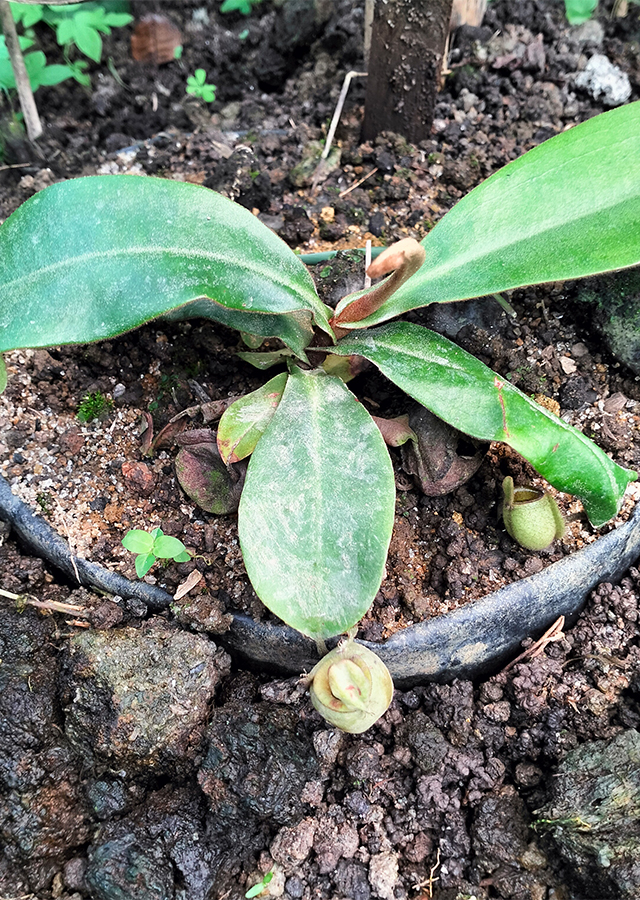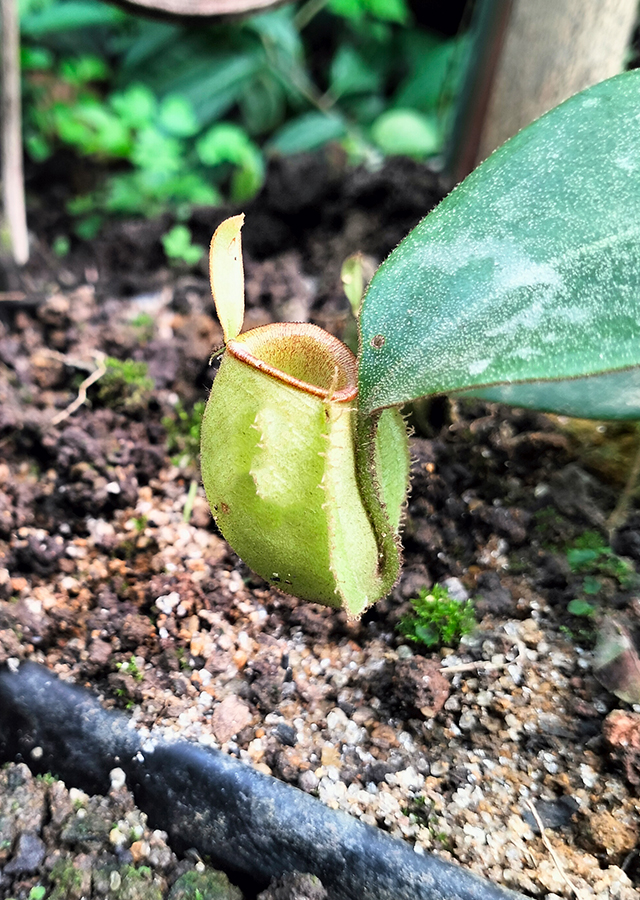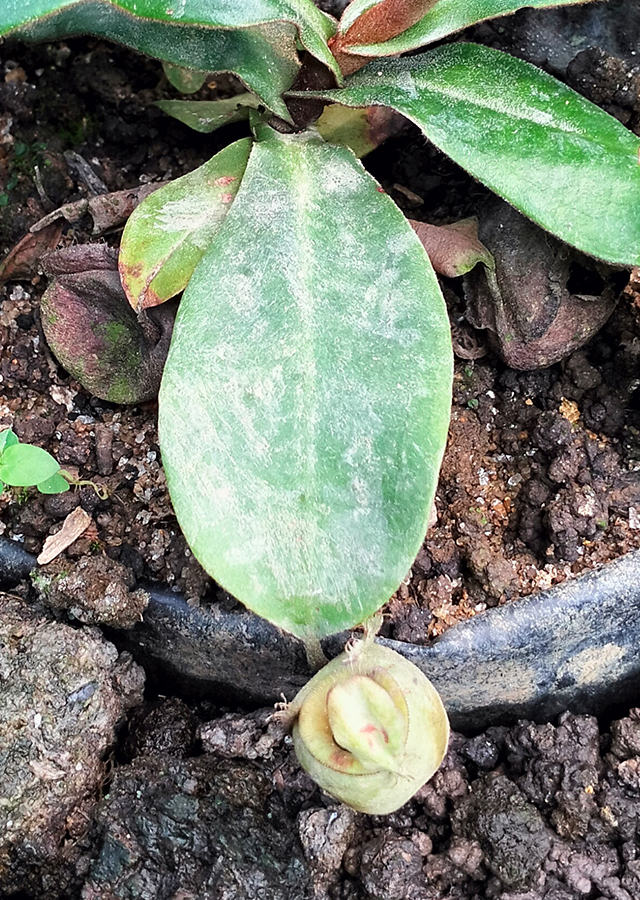Flask-Shaped Pitcher Plant
Nepenthes ampullaria Jack
Nepenthaceae
Location in our garden
Green House



Synonym
Nepenthes ampullacea Jack
Nepenthes ampullaria var. racemosa J.H.Adam & Wilcock
Nepenthes vittata Beck
Habitus
Herbaceous. Herbs semi-wood vines, stem's length is up to 15 m
Part Used
Roots
Stem
Growing Requirements
Need Shade
Habitat
Wetland
Forest
Overview
Nepenthes ampullaria is a pitcher in the shape of a flask. This species is a very typical of the genus Nepenthes, can be found in Borneo, Sumatra, Thailand, Peninsular Malaysia, Singapore, Maluku Islands, and New Guinea. Nepenthes ampullaria is also known as the only "vegetarian" pitcher plant species, because the bag of this plant does not have nectar glands on the lip of the bag so insects are rarely trapped in the bag. This pitcher plant is cultivated for trade, as an ornamental plant in the global market, so the species continues to exist. Nepenthes ampullaria is one of the most commonly used Nepenthes species in traditional medicine.
Vernacular Names
Narrow lip pitcher plant, Monkey cup (English).
Agroecology
Nepenthes ampullaria grows in secondary forests or swamps, and wet open areas, from the lowlands to an altitude of about 2,100 m. Prefers bright indirect sunlight and moist acidic media and lacks nutrients such as peat, sphagnum moss or salt-free cocopeat. Avoid fertilizing, especially with quick-release fertilizers, which can burn or kill the plant, or result in excessive leaf growth without pocket formation.
Morphology
- Stems - slender, has many short branches with a rosette of leaves at intervals on the underside of the stem, but on the higher sections fewer branches and more leaves are borne.
- Leaves - single, spathulat leaf shape, smooth surface, rough and hairy bottom, pointed leaf tip, petiole, < 2 cm long. Tendrils are < 15 cm long. The shape of the crock bag, the height of the bag is < 7 cm, the width of the bag is < 5 cm, the color is green with purplish red spots. Peristome bent and expanded, green color. The pouch cover forms an angle > 180˚, lanceolate. Spur length < 10 mm, unbranched. For branches with rosette leaves, alternate leaf blades, stem to stemless leaves are spear or spoon-shaped, and measure 2–5 by 0.5 cm. At the end of the rosette leaf there is an urn-shaped pouch to an egg, 2-10 cm long which has a narrow lip. The pouches are also green to almost white, with pink or red spots or patches. For leaves at the top of the stem, the leaf blade is narrow and long, about 25 by 6 cm, with the tip extending to form a slender, coiled tendril. Pockets almost never form here, but when they do, they are small, funnel-shaped and don't develop as well as pouches in rosette leaves. These upper pockets are rarely developed and rarely observed, and are thought to be residual structures formed as a result of the plant being suppressed by very poor soils.
- Flowers - green with a width of 1.3 cm, grows on shoots that reach 45 cm in length. Small, yellow, without petals, clustered into erect racemes up to 45 cm long. Dioecious plant, with male and female flowers found on separate plants.
- Fruits - 2.5 cm long, a capsule that ripens from green to brown, splitting when ripe into four parts to release the seeds.
- Seeds - small like threads scattered in the wind.
Cultivation
Propagated by seeds (variable progenies), or stem cuttings. If taking tip cuttings, use 4 internode cuttings (tip plus 3 lower leaves) to prevent rotting of the tender shoot tips before planting. Single cuttings from the bottom of the plant are also possible. Basalt rosettes combined underground can be divided and potted separately.
Chemical Constituents
Gylcosides and phenols.
Traditional Medicinal Uses
- Regulates the menstrual cycle.
- Facilitates the birth of children.
- Relieves asthma, fever, stomachache and dysentery.
- Treats eye inflammation and acts as a stamina enhancer.
Part Used
Reference Sources
- Royal Botanic Gardens. Plants of the World Online: Nepenthes ampullaria Jack. https://powo.science.kew.org/taxon/urn:lsid:ipni.org:names:603652-1#synonyms. 28-07-22.
- Flora Fauna Web. 2022. Nepenthes ampullaria Jack. https://www.nparks.gov.sg/florafaunaweb/flora/3/4/3438. 28-07-22.
- Ismail N A, Kamariah A S, Lim L B L, Ahmad N . Phytochemical and Pharmacological Evaluation of Methanolic Extracts of the Leaves of Nepenthes bicalcarata Hook. F.. International Journal of Pharmacognosy and Phytochemical Research 2015; 7(6); 1127-1138. https://www.researchgate.net/publication/333648518_Two_New_Ethnobotanical_Uses_for_Nepenthes_Ampullaria_Jack_Among_the_Miyanmin_of_Yapsiei_Station_Papua_New_Guinea.
- SHUAIBU BABAJI SANUSI, MOHD FADZELLY ABU BAKAR, MARYATI MOHAMED, SITI FATIMAH SABRAN, MUHAMMAD MURTALA MAINASARA. 2017. ETHNOBOTANICAL, PHYTOCHEMICAL, AND PHARMACOLOGICAL PROPERTIES OF NEPENTHES SPECIES: A REVIEW. Asian Journal Pharmaceutical and Clinical Reseach. Vol 10, Issue 11, 2017. DOI: http://dx.doi.org/10.22159/ajpcr.2017.v10i11.20050.

